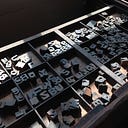Southern Surrealism: Conceptualization to Modernity
The southern Surreal as conceptualized by Clarence John Laughlin has evolved over the past seventy plus years. To focus on a study of the idea as a whole, I must place the concepts and characteristics of Laughlin’s photography across different mediums, mainly literature, music, and fine art, of the decades since. To better understand the concept of southern Surrealism, we must look at the purpose of art through the perspective of Laughlin, and build from there.
“In our society most of us wear protective masks of various kinds, and for various reasons. Very often, the end result is that the mask grows to us, displacing our original characters with our assumed characters.”
This quote is a key characteristic of the southern surreal, emphasizing the undertones and mysteries that lie within people. Laughlin, as a photographer, sought to engage with these unconscious representations through his physical re-imaginings. The above image, “The Mask Grows to Us,” represents this view as Laughlin re-creates the unconscious mode of regional thinking, as members of society assume a role in a capacity that they expect others to place them in.
I will define the southern surreal based on Laughlin’s approach as the underlying representation of an image or word across a medium of art that transcends the actual object or subject, namely in reference to the play on juxtaposition or hypocrisy brought out by the significance of the object or subject regarding the culture it is placed in, namely the South.
Projects that investigate the surreal elements allow a series of images, songs, or words to create a vivid landscape of the underlying themes inherent to a region. For example, Laughlin’s Ghost’s Along the Mississippi delves into the decay of the Old South by displaying the decay and deterioration of southern plantations, the one time symbol of white elitism and slavery. To develop this further I will look into other Laughlin photographs as well as southern works of art in general.
The easiest comparisons to draw on, staying focused on Laughlin’s New Orleans, are the images that came out of the aftermath resulting from Hurricane Katrina. The same unconscious undertones that Laughlin exhibited in his images can be seen in those of the Katrina period. Like the decay and of the old southern ideal that Laughlin captured, the people of New Orleans captured the decay of the urban American problem, specifically for the Blacks in the South.
TRACING SOUTHERN SURREALISM TODAY
Going forward, I chose two sets of images to compare. First is a pair of images that were taken exactly sixty years apart, “Mother Brown” by Clarence John Laughlin as well as an AP photo from Dave Martin. The images both represent black woman against the backdrop of their personal New Orleans. The first image, “Mother Brown” was part of a series called “Images of the Lost.” The second image is from the aftermath of Hurricane Katrina. The surreal quality to these images is two-fold. The backdrop of the images represents the surrealist elements that illuminate the purpose or place of the subjects. In the “Mother Brown” image, the key feature is the sickle shadow hanging above the woman, alluding to the constant overhanging of death in the air. This can be coupled with the backdrop of the post-Katrina image in which death and destruction is literally everywhere in the image. For both of these Black women, the landscape of the South is represented as a looming presence which extends in all directions. The subjects are boxed-in so to speak and confined to not only the region that they live in, but even more specifically the neighborhood and specific area.
The two images of young Black girls in New Orleans is one of the most powerful coupling of images from the twentieth and twenty-first century. The mere allusion that change has occurred in the period of thirty years is smashed in the drastic commonalities pictured above. First, we must focus on the 1973 image of Laughlin. The title “The Disastrous Gate” alludes to an entrance which is apparently not easily accessible. The entrance appears to be criss-crossed with barbed wire and the backdrop is bleak and deserted, even somewhat trashed. The sign above the door is interesting as well, as the store front used to be called “The Good Shepherd,” yet, there is no one inside to lead as such. The coupled image from the aftermath of Hurricane Katrina again represents much the same after a period of three decades. The two siblings sit on a fallen over shopping cart in a deserted city with no access to anything. Again the backdrop is deserted and trashed and offers no hope to the two young girls in the image. While the girl in the Laughlin image is looking directly at the camera, the modern day girls are looking in the distance, as if hope is way off in a corner, remaining unseen.
The Surreal elements of the South have certainly evolved since the conceptualization by Clarence John Laughlin in the middle of the twentieth century, however, some of the things I want to touch on are how across different mediums they have changed both as a means of progress and regress. Above in my example of the images of Laughlin coupled with those of post Katrina New Orleans, I show exactly one example of how this is done. Music for example has embraced the Surreal as well as any mode of art, mainly in the genre of Swamp folk, or southern Gothic, which blends traditional musical roots from both the Black and White South. Photography is one of the mediums where the surreal qualities have remained the same and can be seen to represent the revival of the Old South as well as the decay of it. Over the next few weeks, I will immerse myself in the study of the surrealistic qualities of southern art, as I did with the above four images, for a more descriptive study.

